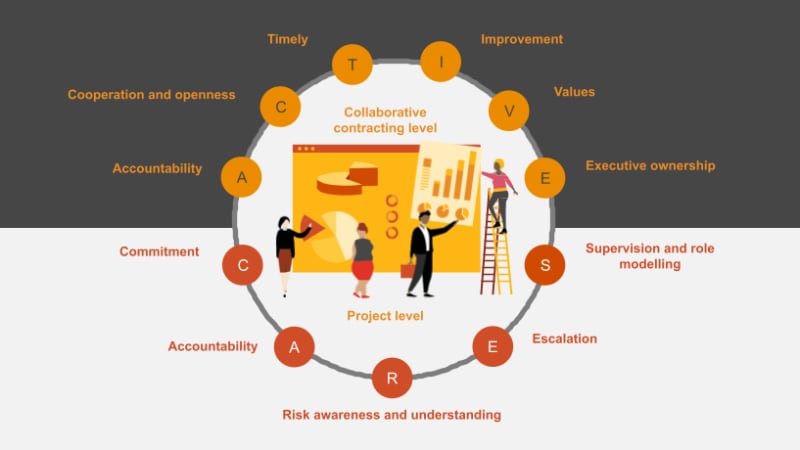The infrastructure challenge facing Australia is vast, with many large-scale, complex projects in the pipeline for delivery over the next decade and beyond. For these projects to be successful, all the parties involved will need to seek ‘best-for-project’ approaches, not only in the technicalities of project design and delivery, but also in how the parties collaborate to manage risk and realise value.
Collaborative projects create an opportunity for project owners, contractors and engineers (collectively ‘proponents’) to share in the risks and opportunities of cost and non-cost performance of large infrastructure projects. If an appropriate level of governance is established and implemented, collaborative contracting arrangements can deliver significant rewards: greater efficiency, better project outcomes, and value for money.
The key elements to successfully develop, implement and deliver collaborative projects are:
- Getting the target cost right.
- Documenting what risks are shared (i.e. the proponents share in cost and time impact within the existing target cost and timeframe), and what risks will result in a target adjustment (i.e. project owner wears).
- Clearly demarcating the allocation of costs between reimbursable costs and corporate overhead (deemed to be part of the fee percentage).
- Developing a cost risk and reward and performance management framework that provides an appropriate balance between risk and reward and that incentivises and aligns the commercial interests of the proponents towards the objectives and/or what is of ‘value’ to the project owner.
- Alignment of team vision, behaviours, attitudes and objectives.
The first four elements are subject to intense (at times) scrutiny and evaluation. However, the fifth element receives less attention, investment and focus, but has the greatest impact on performance.
Cultural and behavioural alignment, as well as commercial alignment, are right at the heart of collaborative contracting and critical to achieving project objectives.
Culture plays a critical role in aligning behaviours of disparate groups of individuals towards a common goal and shared values and principles. Over recent years, sectors outside of engineering and construction have increased their focus on establishing, maintaining and improving cultural alignment to drive performance. From our experience, cultural and behavioural alignment is critical for project owners to maximise value and deliver the project objectives in an efficient, effective and economical manner.
However, for collaborative infrastructure projects, proponents rarely assess whether they’re actually ready to undertake a collaborative contract and/or monitor the level of alignment between the parties to the collaborative contract in the delivery phase.
Successful collaboration begins with a common vision and shared values
Obtaining full value from collaborative contracting arrangements relies as much on the attitudes and behaviours of the project team as it does on the individual performance of the proponents and/or their technical ability and knowledge. Alignment at this level forms a strong basis for shared project priorities and objectives, a genuine commitment to the integrated ‘one team’ approach, and shared ownership to solve problems together that may affect the delivery of the project.
Unfortunately, despite starting out with good intentions, all relationships can easily go sour – and collaborative contracting relationships are no exception. Even if the relationship doesn’t fail spectacularly but just limps along, it’s a wasted opportunity that leaves a great deal of unrealised value. The root causes of troubled relationships stem from cultural misalignment resulting in incongruent behaviours and sub-optimal project outcomes.
One of the challenges in auditing projects being delivered through a collaborative contracting arrangement is to establish a unique and separate project culture from each of the proponents. This can be complex and difficult as individuals need to take off their ‘corporate badges’ and adopt new common values and beliefs of the project. Adopting a pure collaborative approach will challenge individuals to feel comfortable about sharing designs and other commercial and intellectual property, but this level of openness and transparency will be required to build the trust that’s essential to a successful collaboration.
When there’s trust and a ‘no blame’ culture, proponents are more likely to feel confident to take risks, and more likely to be comfortable enough to raise difficult issues and identify opportunities for improvement.
Developing a method to monitor the effectiveness of the establishment, implementation and maintenance of a collaborative culture is important so that proponents can measure the degree of alignment of the project team.
At the very beginning of the project, all the proponents need to invest time and energy in articulating shared behavioural goals and desired ways of working so that these can be embedded through the partnership. However, if there is no monitoring, reinforcement and evaluation of the level of alignment between the proponents on the project, then there is no way of knowing whether or not the proponents are maximising the benefit of delivering the project using a collaborative contracting arrangement and/or understanding how to improve and optimise the level of cultural and behavioural alignment of the project team.

A behavioural maturity assessment framework provides insights into the degree of alignment between the project team, pinpoints the areas needing improvement and provides a baseline to measure progress against throughout the project.
When project and risk indicators are overlaid, proponents gain real insights into how culture is affecting project performance and can get early warning signals of sub-optimal project performance. This level of intelligence provides tangible evidence that will guide proponents to focus on the areas of highest importance for driving project performance and delivering successful project outcomes.
Scrutinising behaviours maximises benefit
Articulating shared desired behaviours is an essential start, but more needs to happen to make sure that all this valuable cultural and behavioural work that everyone has invested in at the outset doesn’t get lost along the way once the project is in full swing. The behaviours need to be translated into relatable actions and embedded in practice. So, the next step is to objectively assess whether the desired behaviours are being demonstrated by all the parties involved, and to intervene where change is needed.
Cooperative behaviours underpinning collaborations with other organisations may be difficult for each party in the collaborative contract to assess objectively or consistently. It’s also likely that proponents in the collaboration will be at different levels of maturity in terms of their culture, behaviours and understanding of what makes a good alliance tick.
Another critical factor for an effective and harmonious alliance is every participant being clear about the part they need to play. When roles and responsibilities are clear, the team can function with efficiency and accountability. That said, it’s also important that roles and skills aren’t unnecessarily siloed. A collaborative arrangement offers opportunities to recognise and appreciate other skill sets and capabilities and to identify opportunities for greater integration, career progression or growth into new collaborative projects.
A useful approach is to engage a trusted reviewer to assess the level of collaboration using a consistent, standardised behavioural assurance framework.
Measuring the level of congruence between the parties to a collaborative contracting arrangement provides useful insights into the health and the level of value being extracted from the arrangement. Using a behavioural assurance framework, scores for each underlying behavioural factor can be determined and aggregated to provide a maturity rating.
Shared gains
Performing an independent, objective health check on the strength of behavioural alignment can identify cultural strengths across the collaborative contract which need to be maximised along with areas of improvement and highlight where greater skills and competencies need to be developed.
In the context of ‘shared gain, shared pain’, it’s in everyone’s interests to develop, reinforce and support the behaviours that underpin harmony and success. The shared gain is not only about financial reward, and goes well beyond reputation and winning future opportunities – it’s also about building a better future by creating infrastructure projects that are successful, sustainable and will benefit the broader community long into the future. Are you ready to be part of the solution?
This sponsored editorial is brought to you by PwC Australia. For more information, visit https://www.pwc.com.au/integratedinfrastructure.

















